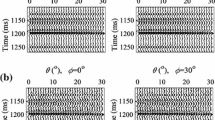Abstract
Seismic flexure is a new geometric attribute with the potential of delineating subtle faults and fractures from three-dimensional (3D) seismic surveys, especially those overlooked by the popular discontinuity and curvature attributes. Although the concept of flexure and its related algorithms have been published in the literature, the attribute has not been sufficiently applied to subsurface fault detection and fracture characterization. This paper provides a comprehensive study of the flexure attribute, including its definition, computation, as well as geologic implications for evaluating the fundamental fracture properties that are essential to fracture characterization and network modeling in the subsurface, through applications to the fractured reservoir at Teapot Dome, Wyoming (USA). Specifically, flexure measures the third-order variation of the geometry of a seismic reflector and is dependent on the measuring direction in 3D space; among all possible directions, flexure is considered most useful when extracted perpendicular to the orientation of dominant deformation; and flexure offers new insights into qualitative/quantitative fracture characterization, with its magnitude indicating the intensity of faulting and fracturing, its azimuth defining the orientation of most-likely fracture trends, and its sign differentiating the sense of displacement of faults and fractures.




















Similar content being viewed by others
References
Al-Dossary, S., & Marfurt, K. J. (2006). 3D volumetric multispectral estimates of reflector curvature and rotation. Geophysics, 71, 41–51.
Bahorich, M. S., & Farmer, S. L. (1995). 3-D seismic discontinuity for faults and stratigraphic features: The coherence cube. The Leading Edge, 16, 1053–1058.
Chopra, S., & Marfurt, K. J. (2007a). Curvature attribute applications to 3D surface seismic data. The Leading Edge, 26, 404–414.
Chopra, S., & Marfurt, K. J. (2007b). Volumetric curvature attributes add value to 3D seismic data interpretation. The Leading Edge, 26, 856–867.
Chopra, S., & Marfurt, K. J. (2010). Integration of coherence and volumetric curvature images. The Leading Edge, 29, 1092–1107.
Cooper, S. P., Goodwin, L. B., & Lorenz, J. C. (2006). Fracture and fault patterns associated with basement-cored anticlines: The example of Teapot Dome, Wyoming. AAPG Bulletin, 90, 903–1920.
Cooper, S. P., Hart, B., Lorenz, J. C., Goodwin, L. B., & Milliken, M. (2002). Outcrop and seismic analysis of natural fractures, faults and structure at Teapot Dome, Wyoming, in Wyoming Geologic Association Guidebook (Fifty Third Field Conference), Wyoming. Geologic Association, 53, 63–74.
Daniel, M., & Barsky, B. (1997). Discrete Gaussian curvature for analysis of a B-spline modeled cornea. SIAM Conference on Geometric Design, Mashville, 3–6 November 1997.
Di, H., & Gao, D. (2014a). Gray-level transformation and Canny edge detection for improved seismic discontinuity detection. Computer & Geosciences, 72, 192–200.
Di, H., & Gao, D. (2014b). A new analytical method for azimuthal curvature analysis from 3D seismic data. SEG Technical Program Expanded Abstract, pp. 1634–1638.
Di, H., & Gao, D. (2014c). A new algorithm for evaluating 3D curvature and curvature gradient from improved fracture detection. Computer & Geosciences, 70, 15–25.
Di, H., & Gao, D. (2015). Volumetric extraction of most positive/negative curvature and flexure attributes for improved fracture characterization from 3D seismic data. Geophysical Prospecting,. doi:10.1111/1365-2478.12350.
Di, H., & Gao, D. (2016). Improved estimates of seismic curvature and flexure based on 3D surface rotation in the presence of structure dip. Geophysics, 81, IM37–IM47.
Gao, D. (2013). Integrating 3D seismic curvature and curvature gradient attributes for fracture detection: Methodologies and interpretational implications. Geophysics, 78, O21–O38.
Gao, D., & Di, H. (2015). Extreme curvature and extreme flexure analysis from 3D seismic data: Implications for fractured reservoir characterization. Geophysics, 80, IM11–IM20.
Ghahfarokhi, P. K., & Wilson, T. H. (2015). Fracture intensity attribute for the Tensleep reservoir at Teapot Dome, Wyoming, USA. Interpretation, 3, SZ41–SZ48.
Hennings, P. H., Olsen, J. E., & Thompson, L. B. (2000). Combining outcrop data and three-dimensional structural models to characterize fracture reservoirs: An example from Wyoming. AAPG Bulletin, 84, 830–849.
Lisle, R. J. (1994). Detection of zones of abnormal strains in structures using Gaussian curvature analysis. AAPG Bulletin, 78, 1811–1819.
Marfurt, K. J., Kirlin, R. L., Farmer, S. H., & Bahorich, M. S. (1998). 3D seismic attributes using a running window semblance-based algorithm. Geophysics, 63, 1150–1165.
Nelson, R. A. (2001). Geologic analysis of naturally fractured reservoirs (2nd ed., p. 332). Houston: Gulf Professional Publishing.
Roberts, A. (2001). Curvature attributes and their application to 3D interpreted horizons. First Break, 19, 85–100.
Schwartz, B. C. (2006). Fracture pattern characterization of the Tensleep Formation, Teapot Dome, Wyoming. M.S. thesis, West Virginia University.
Sigismondi, M. E., & Soldo, J. C. (2003). Curvature attributes and seismic interpretation: Case studies from Argentina basins. The Leading Edge, 22, 1122–1126.
Smith, V. L. (2008). Modeling natural fracture networks: Establishing the groundwork for flow simulation at Teapot Dome, Wyoming. M.S. thesis, West Virginia University.
Tingdahl, K. M., & de Rooij, M. (2005). Semi-automatic detection of faults in 3D seismic data. Geophysical Prospecting, 53, 533–542.
Wilson, T. H., Smith, V., & Brown, A. (2015). Developing a model discrete fracture network, drilling, and enhanced oil recovery strategy in an unconventional naturally fractured reservoir using integrated field, image log, and three-dimensional seismic data. AAPG Bulletin, 99(04), 735–762.
Wood, J. D. (1996). The geomorphological characterization of digital elevation models. PhD Thesis, University of Leicester, UK.
Yu, J. (2014). Using cylindrical surface-based curvature change rate to detect faults and fractures. Geophysics, 79, O1–O9.
Zheng, Z., Kavousi, P., & Di, H. (2014). Multi-attribute and neural network-based fault detection in 3D seismic interpretation. Advanced Materials Research, 838–841, 1497–1502.
Acknowledgments
This study has been supported by the Foundation of State Key Laboratory of Shale Oil and Gas Enrichment Mechanism and Effective Development Award to Dengliang Gao sponsored by Sinopec (China). Thanks go to Dr. Kurt Marfurt from University of Oklahoma for providing newly processed prestack depth-migrated seismic data over Teapot Dome in Wyoming. This paper is a contribution to the West Virginia University Advanced Energy Initiative (AEI) program.
Author information
Authors and Affiliations
Corresponding author
Rights and permissions
About this article
Cite this article
Di, H., Gao, D. 3D Seismic Flexure Analysis for Subsurface Fault Detection and Fracture Characterization. Pure Appl. Geophys. 174, 747–761 (2017). https://doi.org/10.1007/s00024-016-1406-9
Received:
Revised:
Accepted:
Published:
Issue Date:
DOI: https://doi.org/10.1007/s00024-016-1406-9




